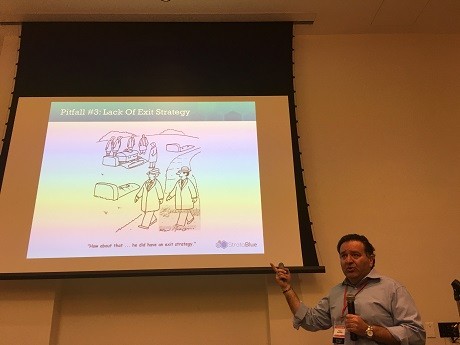Bestritsky Talks About Pitfalls of Starting a Business with Family and Friends

At the March Morris Tech Meetup, Henry Bestritsky, now CEO of StrataBlue (Indianapolis and New Jersey), talked about Binary Tree, a Kendall Park company he founded in 1993 with his best friend.
They became co-CEOs of the company, a situation that worked well for many years, until it didn’t work at all.
Bestritsky shared the lessons he learned with some 70 entrepreneurs and tech enthusiasts who attended the meeting at Fairleigh Dickinson University.
Bestritsky first met his best friend when they were teenagers. They grew up in Brooklyn together, had the same type of background, even the same cultural heritage. After they set up Binary Tree, his friend helped grow the business, which was based on Microsoft consulting. Their first big break came when JPMorgan Chase asked them to migrate their email system from Lotus Notes to Microsoft.
“It was a really big deal, we did it and grew. …That’s when I made my first million. A year later, I lost my first million due to the crash.” The partners stood with each other and made the business work, even during the lean years when they had trouble covering the payroll.
Bestritsky said that, during his time at Binary Tree, the company did some amazing work. For instance, it developed a system to help earthquake victims in Turkey reunite with their families. “We were able to really accomplish something, coming from Brooklyn, to help people around the world,” he said. “That’s what was cool.”
Working with Friends or Family
To Bestritsky, working with his best friend was like working with family.
Bestritsky noted that 35 percent of Fortune 500 firms are family-owned. People start family companies so they can work with people they trust. The family has a vested interest in the company. In most family businesses, the leadership shares core values, there is more job security, the working conditions are better and more flexible and the family members who work in the business are loyal.
People often tell you not to work with family or friends, he noted, and there’s a good reason for that. Things don’t always work out, and when that happens, the owners are left with horrendous stories to tell. “Not only did I lose my best friend, I lost a lot of friends around him,” Bestritsky told the group.
When building a business with a friend does work, it’s amazing, he observed. They were co-CEOs running the business together. “It’s the biggest rush you can imagine.” He noted that having one person with the big ideas and guts of steel, and another person who is the thinker, who can actually execute and take care of operations, is an ideal arrangement.
In his case, he never had to worry about HR, expense reports or paying quarterly taxes. It was all taken care of by his partner. Bestritsky’s job was to maintain the customer relationships and close the big deals. “We relied on one another and the synergy just happened,” he said.
Have a Business Plan
In retrospect Bestritsky realized that the partners had stumbled upon some common pitfalls. For example, they didn’t have a business plan when they started the business. “When we first met, we had six partners who got together. Everyone contributed a couple hundred dollars a month and we got an office on Wall Street.” Arguments started immediately, he said. Two of the guys left, leaving the consulting firm with four people. “But we stuck together, myself and my partner.”
The point is that having a business plan is essential, he said. “Everyone has to know what you are trying to accomplish. That’s simple. It’s Business 101.” However, they were young, he said, and formed the company because they loved doing the work.
But his advice to others is: “Write it down.” He also noted that there are people out there who can help you do this. “When I started my new company, I used Pavita [Pavita Howe, a Morris Tech Meetup organizer and principal at Orange B Strategic Marketing, in Green Brook] to help write my business plan.” he said.
As time went on, Bestritsky realized he wasn’t in sync with his partner anymore. For example, he said, “You might not agree with how your partner treats customers. You have to be in sync because if you’re not, after a while it will really grate on you. You’ll become really uncomfortable.”
Define an Exit Strategy
That’s where having the foresight to define an exit strategy would have come in handy. “You have to say that you’ll be out at a certain point,” and write it down, he said. “I’m out if something happens to my family or I’m out if we reach a certain revenue level,” or even letting someone get out because the company is five years old.
One of the problems Bestritsky ran into was that he couldn’t exit because both partners owned 50 percent of the company. His partner couldn’t afford to buy him out. “I couldn’t buy him out. It was just a death match.”
The problem with being equal partners is that sometimes things aren’t equal. At some point in their working lives, one CEO may be working more than the other CEO, he said. It’s important to lay out the principle that if you work more, you get more. He suggested that partners create a vesting arrangement that incentivizes them to stay. So if they are 50-50 partners, they get 10 percent of the business the first year and so on. If they want to leave after three years, they will only have 30 percent of the business.
A division of labor is important, but you need to treat this seriously. Everyone should know your goals and how you’re going to get there, what kind of employees you will need, what kind of marketing you’ll be using. “What you are able to do then is hold your partner responsible for getting the job done.” Also you’ll be able to document your own actions and see if they are working.
Don’t Put Up With Verbal Abuse
Don’t take things personally, he said, but don’t put up with verbal abuse. In Bestritsky’s case, the partners got too emotionally involved to speak to each other, and had to schedule meetings to do this. “When the communication stops, it’s over,” he said. “I didn’t realize this. I thought I could still fix it.”
Bestritsky said that when things were going south, the partners couldn’t make a decision and would get the executive team involved. Politics started in the office and the atmosphere became poisonous. Early on, the partners should have defined how they would make a decision, even if it meant going to an arbitrator to make a decision for them. “You have to make decisions,” he pointed out. “When you are in sync, the decisions are just assumed. But when you start going at one another, it becomes really difficult.”
He noted that, at one point, he decided to become the chief strategy officer and let his partner be the sole CEO, but that didn’t work out. “What we should have done was have reporting structures where we held each other responsible, based on the goals and responsibilities and based on the vision that we had” for the company. But don’t have partners report to one another, he said. It typically doesn’t work unless your partner is much older and more experienced than you and you feel that you can learn from each other.
Things ended well for Bestritsky. He was able to sell his stock back to Binary Tree in a deal involving Microsoft, and he then entered another venture, StrataBlue, with a cousin. This time, he went in with his eyes open and precautions in place.

